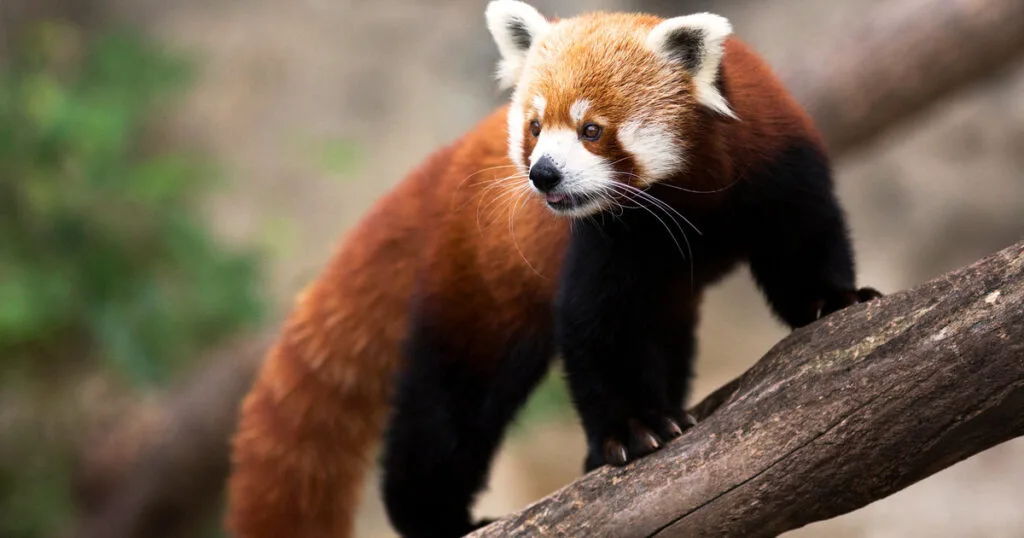Plus 10 Fascinating Facts About These Fluffy Forest Dwellers
With their teddy bear faces, striped tails, and reddish-brown fur, red pandas are some of the most charming animals on Earth. They look like a cross between a fox, a raccoon, and a cat—but they’re actually in a league of their own. Sadly, despite their cuteness, red pandas are endangered, and their numbers are shrinking.
Let’s take a closer look at why red pandas are at risk—and uncover some surprising facts about this lesser-known species.
Why Are Red Pandas Endangered?
According to the International Union for Conservation of Nature (IUCN), red pandas are classified as Endangered, with fewer than 10,000 individuals believed to remain in the wild. Here are the main threats contributing to their decline:

1. Habitat Loss
Red pandas live in the forests of the eastern Himalayas—places like Nepal, Bhutan, India, Myanmar, and southwestern China. These forests are being cleared for agriculture, cattle grazing, logging, and human settlements. As trees disappear, so does the red panda’s home and food supply.
They depend heavily on bamboo, which only grows in specific forest types and elevations. When those forests are cut down, red pandas are left without the one food they rely on most.
2. Poaching and Illegal Trade
Though protected by law in many countries, red pandas are still targeted for their soft fur and as exotic pets. They are illegally captured and sold, often to be kept in poor conditions or smuggled across borders.
Sadly, their docile appearance makes them a target for wildlife traffickers, despite the fact that they do not adapt well to captivity.
3. Fragmentation of Populations
Even when forests aren’t completely destroyed, they’re often fragmented—broken into isolated patches by roads, towns, or farmland. This makes it harder for red pandas to move around, find mates, and maintain a healthy genetic population.
Small, separated groups are more vulnerable to disease, climate change, and even natural disasters.
4. Climate Change
As global temperatures rise, suitable red panda habitat is slowly shifting higher up the mountains. But there’s only so far they can go. Eventually, they run out of space—literally.
Climate change also affects the growth of bamboo, which can lead to food shortages.
🧠 10 Fascinating Red Panda Facts
While their situation is serious, red pandas remain one of the most delightful animals on the planet. Here are some facts that prove just how unique they really are.
1. They’re Not Actually Pandas
Despite their name, red pandas are not closely related to the giant panda. In fact, red pandas belong to their own unique family called Ailuridae. They’re more closely related to raccoons, skunks, and weasels than they are to giant pandas.
2. Bamboo Is Their Favorite Food
Red pandas eat mostly bamboo leaves and shoots, but they’re technically omnivores. They also enjoy fruit, berries, eggs, and occasionally small animals or insects.
Even though they have the digestive system of a carnivore, they’ve adapted to a mostly herbivorous diet.
3. They Have a ‘False Thumb’
Like giant pandas, red pandas have a special, thumb-like bone extension on their front paws. This “false thumb” helps them grasp and manipulate bamboo stalks while eating.
4. They’re Excellent Tree Climbers
Red pandas are arboreal, meaning they spend a lot of time in trees. Their sharp claws and flexible ankles help them climb with ease—even headfirst down tree trunks!
They sleep curled up in the branches and use their long, bushy tails for balance and warmth.
5. They’re Mostly Nocturnal
Red pandas are most active during the early morning and late afternoon. During the day, they rest in trees or hidden spots to avoid predators.
6. Solitary by Nature
Unlike some social animals, red pandas are mostly solitary, except during mating season or when raising young. Each one marks its territory with scent glands and urine to avoid unwanted visitors.
7. They Can Make Strange Sounds
While they’re usually quiet, red pandas can make a variety of noises, including squeals, huff-quacks, and whistles. These sounds are used to communicate during mating or to warn others.
8. Their Babies Are Called Cubs
Female red pandas usually give birth to 1–4 cubs in the summer. The babies are born blind and helpless, staying in a nest for several months before venturing out.
9. They Groom Like Cats
Red pandas use their tongues to groom their fur just like house cats. They’re also known for washing their faces with their front paws—a behavior that only adds to their charm.
10. They’re the Original “Panda”
Red pandas were discovered and named nearly 50 years before the giant panda. In fact, the name “panda” originally referred to the red panda. “Panda” may have come from the Nepali word ponya, meaning “bamboo eater.”
How You Can Help
If you care about red pandas, there are simple ways to get involved:
- Support wildlife conservation organizations like the Red Panda Network
- Avoid products that contribute to deforestation, like unsustainable palm oil
- Raise awareness by sharing information and educating others
- Adopt a red panda symbolically through trusted conservation programs
Final Thoughts
Red pandas are living proof that nature is full of wonder—even in the smallest corners of remote forests. Their endearing behavior, tree-top acrobatics, and peaceful lives have earned them fans worldwide. But without urgent conservation efforts, they could disappear in our lifetime.
Protecting red pandas isn’t just about saving a cute face—it’s about preserving biodiversity and honoring our responsibility to care for the planet we share.

